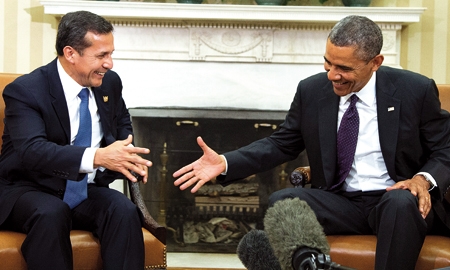Peru has enjoyed average annual GDP growth of 6.4% since 2002, and happily each percentage point in this period has represented a 0.6% drop in poverty. Over the past 11 years, in fact, the national poverty rate has fallen by 23% percentage points.
Elected president in 2011, Ollanta Humala Tasso made poverty reduction a strong point on his agenda since his first day in office, along with social inclusion. Yet despite the progress made, geographically speaking, disparities are still a problem; in 2010, though the national poverty rate was just under 31%, in rural areas it remained high, at 61%.
Peruvian Ambassador to the U.S. Harold Forsyth points out the difficulties in spreading the bounties of the country’s economic success.
“One of our biggest challenges is transferring the successes of economic wealth to the population as a whole. That is partly why the Humala Tasso administration created the Ministry of Social Inclusion and Development,” he says.
After a truly impressive run in terms of GDP growth and export earnings, Peru’s economy seems to finally be feeling the effects of the financial crisis that the rest of the world has been all too aware of since 2008.
In August this year, President Humala Tasso publicly recognized the arrival of the recession on Peruvian shores, saying, “The world is undergoing a tremendous economic crisis. This crisis has now hit Peru and this is why there’s been a decline in tax revenue, which affects various regions.”
Nevertheless, with GDP forecast to grow by a still-healthy 5.5% for the current year (down from an initial estimate of 6.5%), the president remains optimistic. “We have a solid economy that creates the confidence and hope that we are going to move forward… The discussion in Peru is not if we are going to grow or not going to grow, but rather how much we are going to grow,” he said in late August.
International ratings agencies seem to share the president’s optimism. In October, Fitch Ratings gave Peru a BBB+ foreign debt rating, two notches above the lowest investment grade. Previously, in August, Standard and Poor’s had also upgraded the country to BBB+. Moody’s gave Peru a Baa2 with a positive outlook. This places Peru as the second-highest ranked Latin American country.
These upgrades are due, in part, to the country’s low public debt, which fell from 23.3% of GDP in 2010 to 16.6% last year.
“We have a very stable macroeconomic framework,” explains Luis Miguel Castilla Rubio, Minister of Economy and Finance. “The fundamentals in our country are relatively good. Looking at the public sector, we have been capable of running fiscal surpluses allowing us to pursue counter-cyclical policies. Fiscal discipline has been one of the main ingredients along with active debt management.”
While Peru is perhaps most widely known as a tourist destination and increasingly for its mouth-watering cuisine, its rock solid economy (classified as upper middle income by the World Bank) is mainly based on services, mining and mineral exports, and to a smaller yet important extent, agriculture. Other exports include fish and fishmeal, textiles and apparel, machinery, and chemicals.
China recently surpassed the U.S. as Peru’s main trading partner, taking some 17% of the Andean country’s imports. However, Peru’s portfolio of partners is well diversified, thanks to its 19 trade agreements with countries and regions around the world, including MERCOSUR, the U.S., Chile, Mexico, China, South Korea, Japan, Singapore, the EU and the Asia Pacific Economic Cooperation (APEC).
Negotiations are underway to sign trade agreements with Turkey, Guatemala and the Pacific Alliance. More than 95% of Peru’s exports enjoy trade preferences through these myriad agreements.
Ambassador Forsyth highlights that the FTA with the United States is a “great instrument in international law and is considered to be a good model,” adding that it “opens a lot of doors and options for our private sectors.”
Peru also takes part in various other international agreements, aimed at guaranteeing foreign investments against risks. For example, Peru is a host country for dozens of projects through the Multilateral Investment Guarantee Agency (MIGA) of the World Bank Group.
Indeed, Peru offers full security for foreign investments, private and intellectual property rights, legal stability and allows for the free return of capital and profits.
While U.S. investors can rest assured their investments in the Andean nation are safe. Already, some 400 American companies operate in Peru. The government’s ProInversion (the private investment promotion agency) website offers projects portfolios for myriad sectors, ranging from infrastructure, real estate and health to hydrocarbons, mining and telecoms.

0 COMMENTS